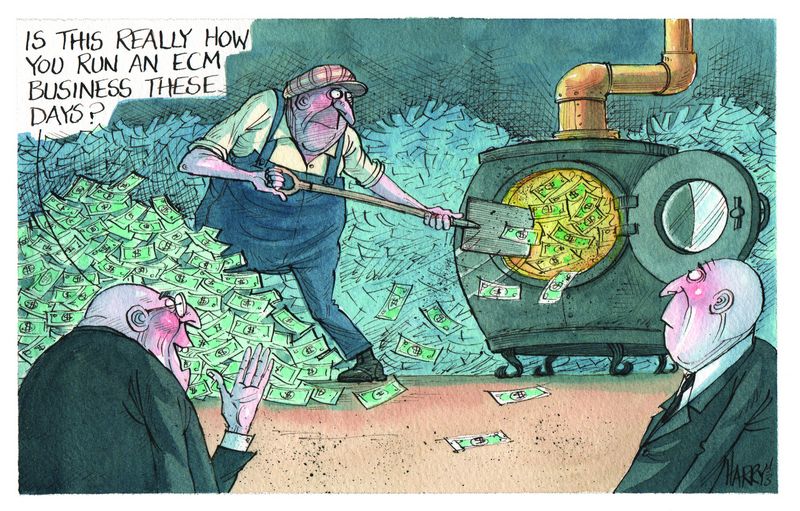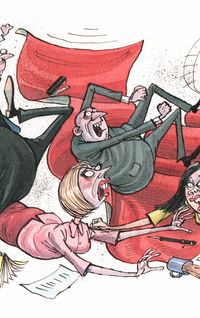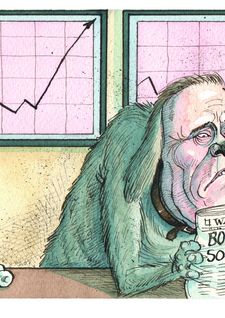ECM block trades virtually vanished during the financial crisis. Now they are big business again as banks vie for jumbo deals and assume massive risks. The year is littered with failed transactions, yet banks can’t help but come back for more.
Far from the recklessness witnessed elsewhere in investment banking, equity capital markets seem to have more in common with actuarial services than casinos. Volumes are tiny compared with debt markets, and innovation is eschewed, considering how little has changed in the past 25 years.
Few ECM bankers may reach the upper echelons of bank management, but theirs is a quiet life of low risk and high fees.
The mere appearance of risk rears its head with a jumbo rights issue underwriting, but the prevalence of sub-underwriting to shareholders means true risk is a fraction of the headline numbers.
Block trades are thus the dirty linen of ECM.
In the years in and around the financial crisis, volumes from block transactions, in which banks buy chunks of shares at a discount from a shareholder before selling them on for a marginal gain, shrank to virtually nothing. Year Zero was 2009, where bought-deal volumes totalled just US$2.5bn in the first 10 months of that year, according to Thomson Reuters data.
Yet slowly at first, then with alacrity, the market regained its mojo, with volumes rising to US$24.7bn in the first 10 months of 2011, and US$44.3bn in the same period in 2013, the bulk of the transactions taking place during a frenetic autumn.
Everything must go
Governments, forced to nationalise troubled lenders at the height of the financial crisis, have capitalised on surging equity valuations to divest their holdings one super-block at a time. Note Sweden’s exit of its remaining NKr20.42bn (US$3.4bn) stake in Nordea on September 25, a week after the UK government’s sale of a £2.97bn (US$4.8bn) stake in Lloyds Banking Group. That boosted block volumes in Western Europe alone to US$31.8bn in the three months through September 2013.
Similarly, European lenders are looking to tune-up their balance sheets ahead of a new round of banking stress tests, while corporates across the continent are briskly unwinding cross-holdings. Bankia, the Valencia lender that received state aid, has been notably busy in recent months, raising €1.675bn (US$2.25bn) by placing its stakes in International Consolidated Airlines Group and Spanish insurer Mapfre in separate third-quarter sales.
Private equity continues to flood the market with deals, as sponsors, sitting on heavy profits from the hard-fought IPOs of the past two years, are keen to cash out mature assets at elevated prices.
Some weeks it seems there has been something in the market for everyone, from chunky slices of renovated state lenders and mid-range German Mittelstand staples, to block sales in once-mighty, now pared-down, Southern European conglomerates.
“This year we have seen all manner of block trades and discounts,” said Jens Voss, head of ECM at Commerzbank. “Some bought deals with aggressive discounts; others on a best efforts basis or pre-marketed with very carefully selected investors. A few are complete surprises, completely blindsiding the market. There is so much distinction and variety in the market.”
Liquidity event
A significant event pushing the market to new heights, particularly in Europe, is the return of an old friend. Last year, the US remained largely a sideline investor, waiting for signs that the lurch from one sovereign crisis to another was finally over.
“The comeback by US investors reflects the perception that Europe’s structural issues are finally getting fixed, that growth is starting to come through, that the continent is heading in the right direction,” said Chicco di Stasi, global head of strategic equity solutions and EMEA head of ECM at UBS.
The problem is how to buy. The lack of liquidity in secondary markets means a reliance on block trades to build positions so even the smallest slug of stock – and even institutions selling – prompts a call to syndicate desks. It is then a matter of guaranteeing a price.
As volume has increased it has posed an unsettling question: can dominant market players duck risky, but league table-enhancing trades while remaining relevant? Put another way: is risk now a prerequisite in a corner of the market that once shunned speculative activity?
The answer to both questions was provided by JP Morgan early this year. Set to experience the ignominy of being placed 13th in Asia-Pacific in the first quarter, the US bank bought fifth place. The US$1.2bn block of Global Logistic Properties was only 62% sold.
Other firms queued up through the year to provide further confirmation. Deutsche Bank and Goldman Sachs made GLP look like a success by selling less than 25% of a block in German real estate company Gagfah, as did Barclays by selling a similar amount of its €1bn block of Ziggo.
An exhaustive list of all the disasters would fill a page – and spoil enjoyment of a book celebrating success.
The price of participation
Such events happen of course. Bankers factor in this sort of thing, assuming that one in, say, 20 transactions will struggle for traction, or will remain underwater long after being unleashed on the market.
“There has been some evidence of misjudgement on deals throughout the course of the year, and of course this will happen – no one is perfect,” said one London-based banker, who preferred not to be named. “Deals can be mispriced for any number of reasons, but that’s a risk that you have to take.”
That’s true, of course: any bank worth its salt needs to blend the right amount of speculative activity into its loan book, for example. No risk, no reward – as Commerzbank’s Voss said, “it is true that we all have to be involved in some risky trades to remain in the game”.
But the nagging question remains: how much is too much? When does risk stop being healthy and start to become self-harming?
The London-based banker said “aggressive deal pricing for the sake of it is no good for anyone in the long term. If you end up with a big block of unsold shares on your books, that overhang helps no one”.
Voss said: “It’s important to ensure that deals have a balanced risk-reward profile, rather than just pricing deals aggressively to win league-table credit.”
No one will admit to taking undue risks with their banks’ capital, but each will happily point the finger at a competitor they believe falls into this category.
Queuing up
This situation is pleasing for sellers such as private equity firms, who can approach 10 banks and get 10 different prices, each potentially more competitive than the last.
Few see activity dimming. “This year’s block market has been fascinating and vibrant and I feel that next year will see a continuation of this activity,” said Gareth McCartney, head of equity syndicate at UBS. “We’ll [continue to] see more sales of financials by European governments.”
McCartney’s enthusiasm is not misplaced. The overnight sale remains the best method of selling stock in a listed company quickly and with minimum stock price impact. Banks just need to get better at it.
They have taken the first step – banks have begun to respond to the absurd time limits given to them in auctions (often 60 minutes, irrespective of size) with a time limit of their own on the validity of their bids. Minor, perhaps, but significant.
To see the full digital edition of the IFR Review of the Year, please click here.
To purchase printed copies or a PDF of this report, please email gloria.balbastro@thomsonreuters.com





























